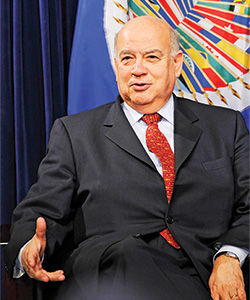
Many falls and swimming holes are found in Jamaica’s Cranbrook Flower Forest. Tourism constitutes approximately 30 percent of Jamaican GDP.
Photo courtesy of Jamaica Tourist Board
Arecent World Bank report on Latin America and the Caribbean noted that the poverty rate for the region dropped from 42 percent in 2000 to 25 percent in 2012, while the ranks of the middle class increased from 22 to 34 percent in those same years. “For the first time ever,” said the report, “the number of people belonging to the middle class now surpass the number of poor, a sign that Latin America and the Caribbean is progressing toward a middle-class region.”
In Jamaica, the signs have been bleaker.
The World Bank Group’s Board of Executive Directors in April 2014 endorsed a new Country Partnership Strategy (CPS) for Jamaica for 2014-2017. It proposes a lending program of $510 million over the next four years, part of a us package of reforms led by the Government of Jamaica with the support of the international community including the International Monetary Fund’s (IMF) Extended Fund Facility and the Inter-American Development Bank’s (IDB) program
Though the country has welcomed investments in recent years from Digicel Group, Nestle and Vistaprint (according to Site Selection’s New Plant Database), poverty in Jamaica has increased from under 10 percent in 2007 to more than 17 percent as recently as 2010, and unemployment is around 15 percent, with 30-percent youth unemployment, said the World Bank. Other sources have tracked the poverty rate ballooning past 20 percent in recent years, with as many as 1 million Jamaicans rated below the poverty line. Tourism helps – a recent report from the Jamaica Tourist Board says 1,466,828 arrivals visited the island between January and August this year, a 2.6-percent rise – but it can only do so much.

José Miguel Insulza, secretary general of the Organization of American States (OAS), speaks at the 55th Lecture of the Americas in Washington, D.C., in April 2014.
Photo courtesy of OAS
“For the past two decades, Jamaica has been trapped in a cycle of low growth, high debt, and limited fiscal space,” said Sophie Sirtaine, World Bank country director for the Caribbean. “The reforms adopted by the government have started restoring confidence in the Jamaican economy. This new strategy is about changing the growth trajectory of Jamaica and boosting competitiveness and private sector development. It also comes with support in scaling up successful programs in social protection, early childhood development and community development.”
Guided by the priorities of the government’s National Development Plan “Vision 2030 Jamaica,” the World Bank Group’s three key areas of support are:
- Modernizing the public sector, including improved customs administration and standardization of the Kingston port, and support for public-private partnerships in energy, transport, waste water treatment and education;
- Creating an enabling environment for private sector growth by fostering investments in high-potential sectors, such as logistics and agriculture; helping reduce the time needed for an entrepreneur to register a new business, obtain a construction permit and pay taxes; providing digital training opportunities for youth; and establishing regional incubators for mobile and climate innovations.
- Building social and climate resilience by strengthening the government’s social protection programs and supporting the development of a comprehensive framework for disaster and climate risk management.
A critical part in the strategy, said the World Bank, will be played by IFC, which will invest in infrastructure, the financial sector, small and medium enterprises and growth-related sectors.
“Jamaica is at a turning point when it can truly leverage the power of the private sector to create new jobs and growth opportunities, strengthen the country’s infrastructure and logistics, and promote competitiveness,” said Jun Zhang, IFC senior manager for the Caribbean.
In April, in Washington, DC, the Secretary General of the Organization of American States (OAS), José Miguel Insulza, and the President of the World Bank Group, Jim Yong Kim, spoke on the “Economic and Social Outlook for Latin America and the Caribbean,” at the 55th Lecture of the Americas, where Insulza reiterated that one of the main challenges of the region is building more inclusive societies. Education is one key.
“Unequal access to quality education and other productive assets is not only the source of wide economic disparities, but it also prevents intergenerational mobility”, said Insulza, who noted that “half the adults aged 25 to 65 years living in indigence have not completed their primary education.”
He also emphasized that lifting people just barely above the poverty line may look good statistically, but doesn’t improve lives. In Latin America and the Caribbean four of every 10 people live in what has been called “the fragile middle,” meaning “they are neither poor nor middle class, they earn between $2 and $10 a day and are very vulnerable to a slowdown in the global economy,” he said.
“At the end of 2013, an estimated 164 million people in Latin America were living in poverty – almost 28 percent of the region’s population – while 66 million people or 11.5 percent were living in extreme poverty or indigence,” said José Miguel Insulza, secretary general of the Organization of American States (OAS), at the 55th Lecture of the Americas in Washington, D.C., in April 2014. “These statistics are too high for a region with our level of development.”